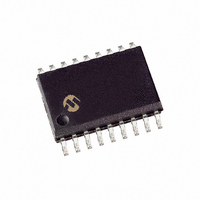PIC16F84A-20/SO Microchip Technology, PIC16F84A-20/SO Datasheet - Page 206

PIC16F84A-20/SO
Manufacturer Part Number
PIC16F84A-20/SO
Description
IC MCU FLASH 1KX14 EE 18SOIC
Manufacturer
Microchip Technology
Series
PIC® 16Fr
Datasheets
1.PIC16F688T-ISL.pdf
(688 pages)
2.PIC16F84A-04P.pdf
(88 pages)
3.PIC16F84A-04P.pdf
(6 pages)
Specifications of PIC16F84A-20/SO
Core Size
8-Bit
Program Memory Size
1.75KB (1K x 14)
Core Processor
PIC
Speed
20MHz
Peripherals
POR, WDT
Number Of I /o
13
Program Memory Type
FLASH
Eeprom Size
64 x 8
Ram Size
68 x 8
Voltage - Supply (vcc/vdd)
4 V ~ 5.5 V
Oscillator Type
External
Operating Temperature
0°C ~ 70°C
Package / Case
18-SOIC (7.5mm Width)
Controller Family/series
PIC16F
No. Of I/o's
13
Eeprom Memory Size
64Byte
Ram Memory Size
68Byte
Cpu Speed
20MHz
No. Of Timers
1
Processor Series
PIC16F
Core
PIC
Data Bus Width
8 bit
Data Ram Size
68 B
Maximum Clock Frequency
20 MHz
Number Of Programmable I/os
13
Number Of Timers
8
Operating Supply Voltage
2 V to 5.5 V
Maximum Operating Temperature
+ 70 C
Mounting Style
SMD/SMT
3rd Party Development Tools
52715-96, 52716-328, 52717-734
Development Tools By Supplier
ICE2000
Minimum Operating Temperature
0 C
Lead Free Status / RoHS Status
Lead free / RoHS Compliant
For Use With
XLT18SO-1 - SOCKET TRANSITION 18SOIC 300MILI3-DB16F84A - BOARD DAUGHTER ICEPIC3309-1075 - ADAPTER 18-SOIC TO 18-SOIC309-1011 - ADAPTER 18-SOIC TO 18-DIP309-1010 - ADAPTER 18-SOIC TO 18-DIPAC164010 - MODULE SKT PROMATEII DIP/SOIC
Data Converters
-
Connectivity
-
Lead Free Status / Rohs Status
Details
Available stocks
Company
Part Number
Manufacturer
Quantity
Price
- Current page: 206 of 688
- Download datasheet (3Mb)
PICmicro MID-RANGE MCU FAMILY
14.3
14.3.1
DS31014A-page 14-4
CCP Pin Configuration
Capture Mode
In Capture mode, CCPRxH:CCPRxL captures the 16-bit value of the TMR1 register when an
event occurs on pin CCPx. An event is defined as:
• Every falling edge
• Every rising edge
• Every 4th rising edge
• Every 16th rising edge
An event is selected by control bits CCPxM3:CCPxM0 (CCPxCON<3:0>). When a capture is
made, the interrupt request flag bit, CCPxIF, is set. The CCPxIF bit must be cleared in software.
If another capture occurs before the value in register CCPRx is read, the previous captured value
will be lost.
As can be seen in
Timer1 can also be used as the timebase for other operations. The time between two captures
can easily be computed as the difference between the value of the second capture that of the
first capture. When Timer1 overflows, the TMR1IF bit will be set and if enabled an interrupt will
occur, allowing the time base to be extended to greater than 16-bits.
In Capture mode, the CCPx pin should be configured as an input by setting its corresponding
TRIS bit.
Figure 14-1: Capture Mode Operation Block Diagram
The prescaler can be used to get a very fine average resolution on a constant input frequency.
For example, if we have a stable input frequency and we set the prescaler to 1:16, then the total
error for those 16 periods is 1 T
is 12.5 ns. This technique is only valid where the input frequency is “stable” over the 16 samples.
Without using the prescaler (1:1), each sample would have a resolution of T
Note:
Note:
Timer1 must be running in timer mode or synchronized counter mode for the CCP
module to use the capture feature. In asynchronous counter mode, the capture
operation may not work.
If the CCPx pin is configured as an output, a write to the port can cause a capture
condition.
CCPx Pin
Figure
14-1, a capture does not reset the 16-bit TMR1 register. This is so
edge detect
Q’s
Prescaler
CY
1, 4, 16
and
. This gives an effective resolution of T
CCPxCON<3:0>
Set flag bit CCPxIF
Capture
Enable
CCPRxH
TMR1H
1997 Microchip Technology Inc.
CCPRxL
TMR1L
CY
/16, which at 20 MHz
CY
.
Related parts for PIC16F84A-20/SO
Image
Part Number
Description
Manufacturer
Datasheet
Request
R

Part Number:
Description:
Manufacturer:
Microchip Technology Inc.
Datasheet:

Part Number:
Description:
IC MCU FLASH 1KX14 EE 18DIP
Manufacturer:
Microchip Technology
Datasheet:

Part Number:
Description:
IC MCU FLASH 1KX14 EE 18SOIC
Manufacturer:
Microchip Technology
Datasheet:

Part Number:
Description:
IC MCU FLASH 1KX14 EE 18DIP
Manufacturer:
Microchip Technology
Datasheet:

Part Number:
Description:
IC MCU FLASH 1KX14 EE 18DIP
Manufacturer:
Microchip Technology
Datasheet:

Part Number:
Description:
IC MCU FLASH 1KX14 EE 18DIP
Manufacturer:
Microchip Technology
Datasheet:

Part Number:
Description:
IC MCU FLASH 1KX14 EE 18SOIC
Manufacturer:
Microchip Technology
Datasheet:

Part Number:
Description:
IC MCU FLASH 1KX14 EE 20SSOP
Manufacturer:
Microchip Technology
Datasheet:

Part Number:
Description:
IC MCU FLASH 1KX14 EE 18SOIC
Manufacturer:
Microchip Technology
Datasheet:

Part Number:
Description:
IC MCU FLASH 1KX14 EE 20SSOP
Manufacturer:
Microchip Technology
Datasheet:

Part Number:
Description:
IC MCU FLASH 1KX14 EE 20SSOP
Manufacturer:
Microchip Technology
Datasheet:

Part Number:
Description:
IC MCU FLASH 1KX14 EE 20SSOP
Manufacturer:
Microchip Technology
Datasheet:

Part Number:
Description:
IC MCU CMOS 4MHZ 1K FLASH 18-DIP
Manufacturer:
Microchip Technology
Datasheet:

Part Number:
Description:
IC MCU CMOS 20MHZ 1K FLASH 18DIP
Manufacturer:
Microchip Technology
Datasheet:

Part Number:
Description:
IC MCU CMOS 4MHZ 1K FLASH 18SOIC
Manufacturer:
Microchip Technology
Datasheet:











